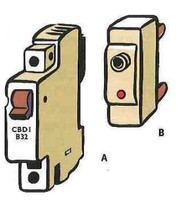The most common time that people have to deal with their electrical wiring is when a fuse blows or circuit-breaker trips. However, there is some wiring that homeowners can do themselves. Find out about what code this work must follow and how to deal with fuses or circuit-breakers.
The permanent cabling and fittings in your home are called electrical installations. A licensed electrician generally carries out work on electrical installations and fittings.
Electrical installations can age and can become overloaded, particularly in old homes where the wiring was not designed for the number of electrical appliances in use today.
Warning signs that the installations in your home are becoming dangerous include plugs and sockets that are hot to the touch or have brown scorch marks on them, fuses that blow and circuit breakers that trip for no reason, and flickering lights.
These signs may mean that the wiring in your home needs upgrading. If you a concerned, contact a licensed electrician. When buying a house, or if you notice any of the above warning signs, have a licensed electrician or electrical inspector check the internal wiring. They will be able to tell you if repairs are necessary and estimate the cost.
Homeowners are permitted to undertake wiring in strict accordance with electrical code ECP51. However, this should not be attempted unless the homeowner is confident that they have the knowledge, tools, and skills necessary for the task.
An inferior job can be considerably more expensive, in time and money, than paying a properly licensed electrician to do the work first time
Failure to follow the requirements of ECP51 could cause an unsafe situation and lead to electric shock or fire.
Fuses and circuit breakers
The switchboard protects the electrical wiring system in your home. It comprises the main power switch, along with a number of fuses, or circuit breakers. Each fuse or circuit breaker corresponds to a different area of wiring in your home.
In the event of an electrical fault the fuse will blow or the circuit breaker will trip. The power to the corresponding area of the house will be shut off, to prevent overloading or fire.
The main difference between a circuit breaker and a fuse is that a circuit breaker can be reset; whereas once a fuse blows it must be replaced.
Before you replace a fuse, always turn off the main power switch and all appliances and lights that are on that fuse. Always replace a fuse with the correct current rating. A fuse with too high a current rating could allow excessive current to flow through the circuit, leading to overheating and possibly fire.
If a fuse keeps blowing, call a licensed worker. If possible, replace the fuses in your switchboard with plug-in circuit breakers of the same rating, as these are safer to use and do not require replacing.
It is always a good idea to know what each fuse or circuit breaker protects. Switchboards are normally labelled. If yours is not, next time you have electrical work done, ask your licensed worker to do this for you. This can save you time in identifying a blown fuse or which circuit breaker to switch off, should the need arise.
How to replace a fuse
Follow this guide when replacing some types of fuses:
- Turn off the main power switch at the switch board.
- Look inside the switchboard for a list of the equipment or circuits each fuse controls. Usually one fuse controls a certain area of the house, such as the kitchen, or certain types of equipment, like lighting.
- If you can’t tell which fuse has blown, pull out, inspect, and replace each fuse, one at a time.
- Once identified, switch off lights and unplug all appliances on the faulty circuit.
- Replace the fuse wire. There are a number of different types of fuses. If you are not sure, the best way to replace a fuse is to examine one of the intact fuses in your switchboard and copy the way the wiring runs in the carrier.
- Make sure you use the correct current rating wire. The current is generally indicated on the front of the fuse carrier.
- Lighting circuits typically use 5 amp wire but not greater than 10 amp.
- Socket outlets use 10 amp wire but not greater than 15 amp.
- Large appliances, such as electric stoves, may use a larger size. - Make sure no excess wire is sticking out of the fuse carrier.
- Replace the fuse carrier and turn on the main power switch.
- Check all appliances, light fittings and cords that were in use when the circuit failed. Replace or repair faulty equipment. Check that the fuse did not blow due to overloading the circuit.
- If the fuse blows again, call a licensed electrician.
Never be tempted to replace a fuse wire with a larger size of fuse wire, or another object. Doing so may result in fire.
If a fuse has blown it is because of an overload situation or a fault has occurred on the circuit. If you replace a fuse and it still blows, you should call a licensed worker.
How to check your circuit breaker

- If your power goes off because your circuit breaker has tripped, look for the lever in the 'off' position (A) or where the button has popped out (B).
- Switch off lights and unplug all appliances on the faulty circuit.
- Push the operating lever to the 'on' position (A), or push in the button on the circuit breaker (B).
- If the circuit breaker continues to trip, call a licensed electrician.
Fuses and circuit breakers safety checklist
- Can you change a fuse correctly?
- Are all fuse wires the correct size for the circuits on your switchboard?
Is it a rare occurrence for a fuse to blow in your home? If this happens regularly have an electrician find the cause.
Last updated